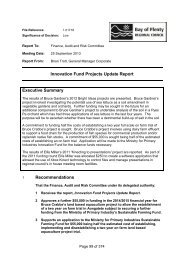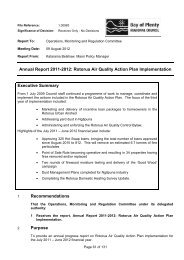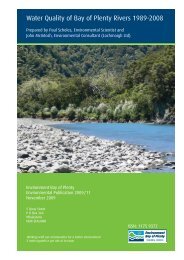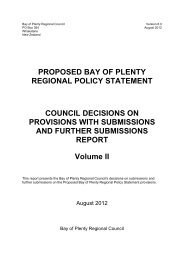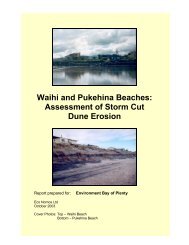Odour Threshold Investigation 2012 - Bay of Plenty Regional Council
Odour Threshold Investigation 2012 - Bay of Plenty Regional Council
Odour Threshold Investigation 2012 - Bay of Plenty Regional Council
Create successful ePaper yourself
Turn your PDF publications into a flip-book with our unique Google optimized e-Paper software.
With continuing exposure to a certain odour concentration, the sensation gradually<br />
decreases, and may even disappear. Olfactory fatigue from continued exposure to<br />
an odour may affect a person’s sense <strong>of</strong> smell. This phenomenon is called<br />
adaptation 5, 10 . Adaptation begins to reduce perceived odour intensity and quality<br />
during the first inhalation. Adaptation may reduce both perceived odour intensity and<br />
perceived odour quality. Although adaptation takes some time to develop, recovery<br />
takes place more quickly.<br />
Ruijten et.al reports that while sensitivity to an odour may decrease after sniffing a<br />
sample, 80 to 90% recovery generally occurs within a minute with complete<br />
recovery in several minutes 3, 10 .<br />
Due to the special olfactory nature <strong>of</strong> H 2 S, during exposure, most subjects<br />
experienced an exponential decrease <strong>of</strong> intensity that dropped to a steady level<br />
within 2-5 minutes, and did not change appreciably up to 15 minutes later 11 . One <strong>of</strong><br />
eight subjects indicated virtually complete loss <strong>of</strong> odour sensation and another<br />
substantial loss which is attributed to reversible paralysis <strong>of</strong> the olfactory nerve. The<br />
other six showed an approximately 50% decrease <strong>of</strong> perceived intensity, which<br />
corresponds to an apparent four-fold reduction in the H 2 S concentration. After<br />
breathing pure air, the sensitivity recovered almost completely in about four<br />
minutes 12 .<br />
2.5 <strong>Odour</strong> effects<br />
In New Zealand the nuisance effects <strong>of</strong> odour are commonly described by the term<br />
‘objectionable or <strong>of</strong>fensive’. This concern with odour is regulated within the<br />
Resource Management Act (RMA) 13 . For some compounds, objectionable or<br />
<strong>of</strong>fensive effects can occur at very low concentrations, usually far less than the<br />
concentrations associated with adverse health effects. However, other compounds<br />
only have objectionable or <strong>of</strong>fensive effects at relatively high concentrations, at<br />
which point some <strong>of</strong> the contaminants in the odour may also be causing direct<br />
health effects such as skin, eye or nose irritation. Repeated or prolonged exposure<br />
to odour can lead to a high level <strong>of</strong> annoyance, and the receiver may become<br />
particularly sensitive to the presence <strong>of</strong> the odour.<br />
The health effects that have been reported as being associated with odour<br />
exposures include nausea, headaches, retching, difficulty breathing, frustration,<br />
annoyance, depression, stress, tearfulness, reduced appetite, and being woken in<br />
the night . There are also social effects such as reduced enjoyment <strong>of</strong> the outdoors<br />
and embarrassment in front <strong>of</strong> visitors. All <strong>of</strong> these contribute to a reduced quality <strong>of</strong><br />
life for the individuals who are exposed.<br />
People can also develop physiological effects from odour even when their exposure<br />
is much lower than that normally associated with the reported health effects. This<br />
effect is sometimes termed ‘odour worry’ and is due to the perception that if there is<br />
a smell it must be doing physical harm.<br />
10 Shusterman, D, 1992, Critical Review: The Health Significance <strong>of</strong> Environmental <strong>Odour</strong> Pollution.<br />
Arch. Environ. Hlth 47: 76-88.<br />
11 Ekman, G., B. Berglund, U. Berglund, 1967, Perceived intensity <strong>of</strong> odour as a function <strong>of</strong> time<br />
adaptation. Scand. J. Psychol. 8: 177-186.<br />
12 Ruijten, M., van Doorn, R. & van Harreveld, A, 2009, Assessment <strong>of</strong> odour annoyance in chemical<br />
emergency management, National Institute <strong>of</strong> Public Health and the Environment, RIVM Report<br />
609200001/2009, The Netherlands.<br />
13 Resource Management Act (1991), Section 17 (3) (a) - “require a person to cease, or prohibit a person<br />
from commencing, anything that, in the opinion <strong>of</strong> the Environment Court or an enforcement <strong>of</strong>ficer, is<br />
or is likely to be noxious, dangerous, <strong>of</strong>fensive, or objectionable to such an extent that it has or is likely<br />
to have an adverse effect on the environment.”<br />
Environmental Publication <strong>2012</strong>/06–A review <strong>of</strong> odour properties <strong>of</strong> H 2 S <strong>Odour</strong> <strong>Threshold</strong> <strong>Investigation</strong> <strong>2012</strong> 7



